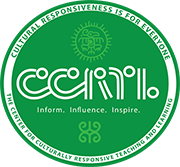“This day could not have been possible without your dedication and commitment to the important work around equity and I can not thank you enough for sharing your time during such a busy time of year in our field.”
VALIDATE, AFFIRM, BUILD AND BRIDGE (VABB™)
VALIDATE AND AFFIRM (VA)
Validate and Affirm (VA)—make culturally and linguistically legitimate and positive, that which has been illegitimate and negative by the institution of education and mainstream media; understanding the complexity of culture and the many forms it takes (including age, gender, and social class), which will then create opportunities for making meaningful experiences in school
Validation — the intentional and purposeful legitimization of the home culture and language of students
Affirmation — the intentional and purposeful effort to reverse the negative stereotypes of non-mainstream cultures and languages portrayed in historical perspectives
BUILD AND BRIDGE (BB)
Build and Bridge (BB)—the cultural knowledge that needs to be developed and connected to academic use, within the school context, after students’ cultures have been validated and affirmed
Building—understanding and recognizing the cultural and linguistic behaviors of students and using those behaviors to foster rapport and relationships with them
Bridging—providing the academic and social skills students will need to have success beyond the classroom; evident when students demonstrate they can navigate school and mainstream culture successfully
Being culturally responsive means that you plan to validate, affirm, build, and bridge your students (or people in general) when you talk to them, in how you relate to them, and in how you teach them. We all have different cultural behaviors based on who we are and how we got here. We want everyone to understand and know when to use the most appropriate cultural and linguistic behaviors for any situation, without losing who they are culturally and linguistically.
“Your messages were highly captivating. Your discourse on linguistics taken from a
cultural perspective was refreshing, I have not heard topic discussion on language presented in such a manner before that resonated well. Mr Hollie, thank you for your mind and your steadfast insights to reshaping and refocusing our lens when addressing
culture. I am inspired.”
BEYOU
Created by Carrie Eicher, Lead CLR Advisor
The explicit validation and affirmation of your students, around their cultural behaviors, is the key to CLR. VA-ing your students triggers the building and bridging and by extension, your students buy-in to being situationally appropriate. Your VA has to be intentional and purposeful, consistent and authentic, and proactive and reactive (i.e., using teachable moments). When do your students have the opportunity to be who they are in the instructional context? BeYou is the acronym that I share with teachers to actively encourage their students to view their cultural and linguistic behaviors as assets and not liabilities, in school.
BeYou, as a concept, is a challenge to us all to ensure that students can be who they are at school. It is a direct rebuttal to the often used SLANT protocol (Sit up tall, Listen, Ask questions, Nod your head, and Track the teacher) that has become ubiquitous in schools. Note that there are many variations of SLANT. We want students to BeYou (VA) and to SLANT (BB) situationally. As it stands now, the use of SLANT is imbalanced when looking through a CLR lens. Its overemphasis on the alignment with school cultural behaviors and expectations can be limiting or detrimental to efforts to embrace students’ home cultures. BeYou is not meant to counter efforts to build and bridge toward situational appropriateness; it is intended to create more structured opportunities at school for students to be themselves culturally and linguistically.


